The Assassination Tour in Sarajevo provides a captivating exploration of one of the most pivotal events in modern history. Visitors can retrace the fateful steps that led to the 1914 assassination of Archduke Franz Ferdinand, an act that triggered a chain of events culminating in the outbreak of World War I. As they visit the key sites associated with this tragedy, tour-goers gain a deeper understanding of the political tensions and nationalist sentiments that fueled the assassination. This immersive experience not only commemorates a crucial moment but also invites participants to reflect on the lasting impact of this seminal event on global relations.
Quick Points
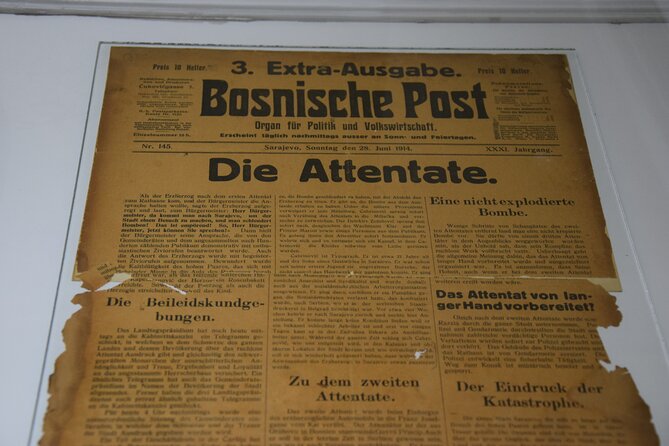
-
The Assassination Tour in Sarajevo highlights the pivotal 1914 assassination of Archduke Franz Ferdinand, which served as the catalyst for World War I.
-
The tour explores key sites associated with the assassination, allowing visitors to visualize the location and circumstances of this historic event.
-
The tour provides insights into the broader political and social tensions in early 20th-century Europe that led to the Archduke’s assassination and the subsequent outbreak of World War I.
-
The tour emphasizes the significance of nationalism and imperialism as key factors that contributed to the heightened tensions and geopolitical rivalries preceding the assassination.
-
The Assassination Tour offers a deeper understanding of the lasting impact and legacy of this pivotal moment in history, which continues to captivate interest and shape contemporary discourse.
Historical Context of the Assassination
The Assassination Tour in Sarajevo provides a profound insight into one of the pivotal moments that sparked the outbreak of World War I.
On June 28, 1914, Archduke Franz Ferdinand of Austria and his wife Sophie were assassinated by Gavrilo Princip, a member of the Black Hand, a Serbian nationalist organization.
This event, known as the Sarajevo Assassination, was a catalyst for the escalating tensions between the major European powers at the time, ultimately leading to the outbreak of the Great War.
The tour delves into the historical context, exploring the complex web of alliances, nationalistic aspirations, and geopolitical rivalries that contributed to this momentous occurrence.
You can also read our reviews of more tours and experiences in Sarajevo.
Archduke Franz Ferdinand’s Fateful Visit
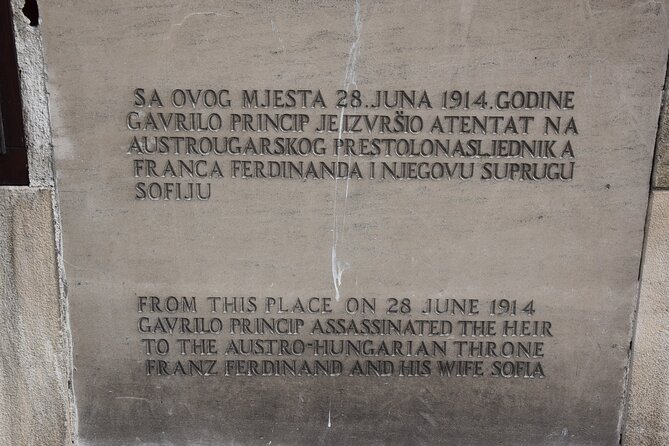
On June 28, 1914, Archduke Franz Ferdinand, the heir to the Austro-Hungarian throne, paid a fateful visit to the city of Sarajevo.
The Archduke and his wife, Sophie, were touring the city when a young Bosnian Serb named Gavrilo Princip assassinated them.
This dramatic event sparked the beginning of World War I, leading to the downfall of the Austro-Hungarian Empire and dramatically reshaping the geopolitical landscape of Europe.
The assassination tour explores the historical significance of this pivotal moment, guiding visitors through the sites where the fateful events unfolded and providing context about the broader political and social tensions that led to the tragedy.
The Assassin’s Path and Escape
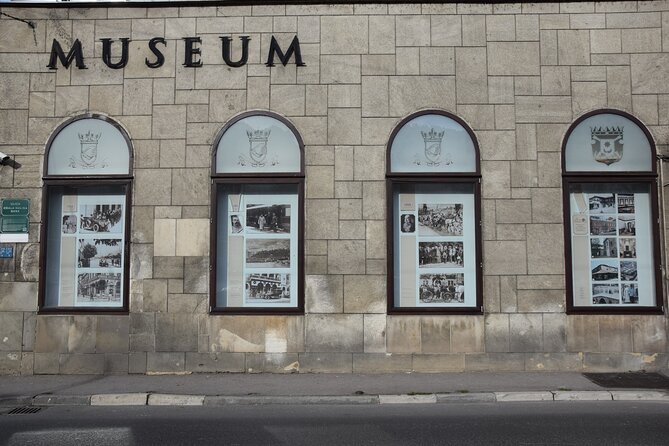
Gavrilo Princip, the young Bosnian Serb assassin, had carefully plotted his attack on the Archduke’s motorcade.
As the Archduke’s car slowed at a tight corner, Princip seized his chance and fired two shots, fatally wounding the Archduke and his wife.
Princip’s escape after the assassination was equally calculated:
- He fled to a nearby shop, where he attempted to take his own life but was apprehended by authorities.
- Despite his young age, Princip was sentenced to 20 years in prison, the maximum penalty allowed for someone under the age of 20 at the time of the crime.
- His act of defiance and the ensuing chain of events ultimately sparked the outbreak of World War I, a conflict that would reshape the world.
Aftermath and Consequences of the Assassination
Although the assassination of Archduke Franz Ferdinand was a pivotal moment in history, its aftermath and consequences reverberated far beyond Sarajevo. The assassination catalyzed the start of World War I, leading to millions of deaths and the collapse of several empires. It also had lasting political and social impacts, with tensions between Serbia and Austria-Hungary escalating and nationalism surging across Europe.
| Aftermath | Consequence | Impact |
|---|---|---|
| Austria-Hungary declared war on Serbia | Outbreak of World War I | Millions of deaths |
| Increased tensions between Serbia and Austria-Hungary | Rise of nationalism across Europe | Collapse of empires |
| Heightened global political instability | Long-lasting regional and international conflicts | Enduring impact on international relations |
Visiting the Assassination Sites
The tour takes visitors to the key sites connected to the assassination of Archduke Franz Ferdinand in Sarajevo on June 28, 1914.
Participants explore the historic Hotel Europe, where the Archduke stayed, and the Sarajevo National Theatre, near the spot where the first assassination attempt occurred.
The tour provides a deeper understanding of the events, allowing visitors to:
- Visualize the location and circumstances of the assassination.
- Appreciate the broader historical context and significance of the incident.
- Gain insights into the lasting impact of this pivotal moment in history.
- Bosnian Cooking Lessons
- Sarajevo: Mostar, Konjic, Dervish House, Pocitelj & Kravice Falls
- Mostar & Herzegovina 4 Cities Day-Tour From Sarajevo (Fees Incl.)
- Srebrenica Genocide Study Tour – Day Tour From Sarajevo
- ROSES of SARAJEVO (Official War Tour 92/95) – Story of a Survivor
- Sarajevo Essential Full Walking Tour
The Role of Nationalism and Imperialism
Nationalism and imperialism were key factors that contributed to the tense geopolitical climate preceding the assassination of Archduke Franz Ferdinand.
The rise of nationalist movements in the Balkans, fueled by a desire for self-determination, collided with the expansionist ambitions of the Austro-Hungarian Empire.
This combustible mix of competing ideologies and territorial claims created an atmosphere of distrust and heightened tensions.
The assassination was seen as an attack on the Austro-Hungarian rule, with far-reaching consequences that ultimately led to the outbreak of World War I.
Understanding this broader context is crucial for appreciating the historical significance of the events in Sarajevo and their lasting impact on the region and the world.
Sarajevo’s Lasting Legacy From the Assassination
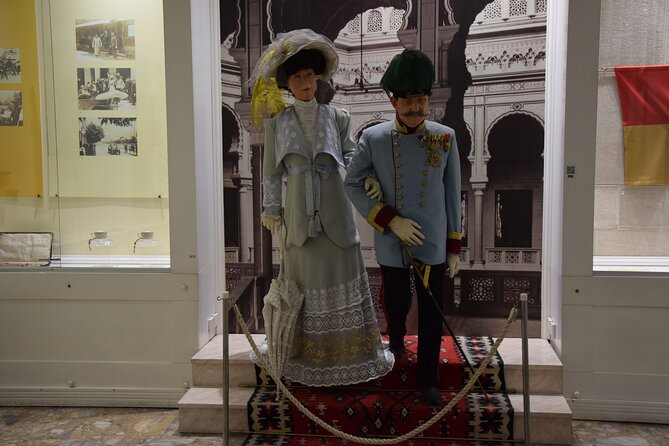
As the assassination of Archduke Franz Ferdinand in Sarajevo in 1914 plunged the world into the devastation of World War I, the city has since become inextricably linked to this pivotal historical event.
Sarajevo’s lasting legacy from the assassination encompasses several key aspects:
-
It solidified the city’s reputation as a site of geopolitical significance, where the collision of empires and ideologies had dramatic consequences.
-
The assassination sparked a renewed interest in Sarajevo’s history and its role as a cultural crossroads, leading to increased tourism and preservation efforts.
-
The event’s enduring impact has made Sarajevo a symbol of both the fragility and resilience of peace, serving as a sobering reminder of the costs of conflict.
Reflecting on the Significance of the Event
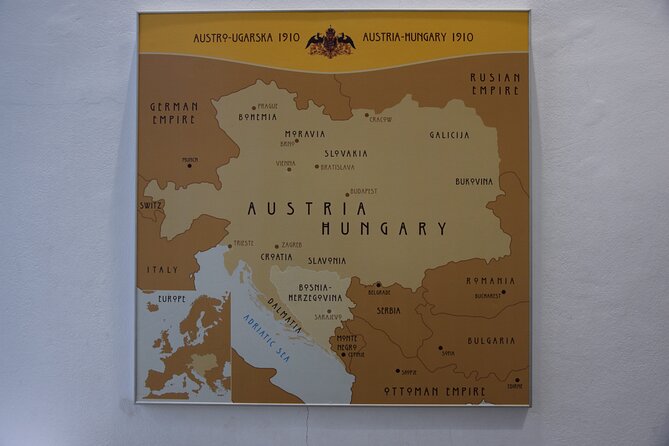
The assassination of Archduke Franz Ferdinand in Sarajevo in 1914 remains a defining moment in world history, one that still captivates historians and the public alike.
The cascading events that followed – the outbreak of World War I, the collapse of empires, and the redrawing of global power dynamics – have made this assassination one of the most consequential in modern times.
Though the motivations and context behind the attack continue to be analyzed, the enduring legacy of that fateful day in Sarajevo remains clear.
It was a pivotal turning point that would reshape the course of the 20th century, with ramifications that still reverberate today.
Since You Asked
Can I Bring Food and Drinks on the Tour?
Participants can bring snacks and beverages on the tour, but the tour operator doesn’t provide any food or drink. Visitors should plan accordingly and bring any refreshments they may want during the approximately 2-hour excursion.
Is the Tour Wheelchair Accessible?
The tour is wheelchair accessible. According to the overview, the meeting point, tour duration, and end point all accommodate travelers with mobility needs. Entrance fees for the included sites are also covered, ensuring an accessible experience.
Can I Take Photos During the Tour?
Yes, visitors are generally allowed to take photos during the tour. However, participants should be mindful of any restrictions or guidelines provided by the tour guide to respect the historical sites and ensure an enjoyable experience for all.
How Many Breaks Are Included During the Tour?
The tour overview doesn’t explicitly mention any scheduled breaks. However, with an approximate duration of 2 hours, there may be opportunities for short breaks or free time during the experience for participants to rest or explore on their own.
Is There an Option to Extend the Tour Duration?
There’s no information provided about extending the tour duration. The overview states the tour lasts approximately 2 hours, with free time afterward. The tour doesn’t appear to offer options for extending the duration beyond the specified timeframe.
The Final Verdict
The Assassination Tour in Sarajevo provides a captivating exploration of the pivotal event that ignited World War I. Visitors gain a profound understanding of the political and social tensions underlying the assassination of Archduke Franz Ferdinand, and the lasting impact it had on global relations and the rise of nationalism. The tour’s significance lies in its ability to commemorate a crucial moment in history and encourage reflection on the enduring consequences of such watershed events.
More Tours in Sarajevo
- Bosnian Pyramids Visoko Mysterious Tour
- Siege of Sarajevo War Tour, 4-Hour Guided European Playground of Death
- Sarajevo Old Town Walking Tour Bosnian Ethnic Food and Coffee
- Sarajevo to Belgrade: One-Way With Srebrenica Genocide Study Tour
- Rafting at River Neretva – VIRTUAL TOUR
- Private Tour to Konjuh : Relaxation in a Protected Landscape
More Tour Reviews in Sarajevo
- Bosnias Treasures: 7-Day Private Tour
- From Sarajevo: Day Trip to Travnik, Jajce Pliva Lakes, Watermills
- 7-Day Wine Tour and Horseback Riding for Small Group in Bosnia
- Private Transfer From Sarajevo Airport (Sjj) to Srebrenica
- Feel the Heart of Sarajevo – City Tour | Old Town – Baščaršija
- Višegrad Tour – Visit to the UNESCO Bridge and AndrićGrad
Not for you? Here's more things to do in Sarajevo we have recnetly reviewed
- 4 Best Guided Tours In Sarajevo
- 9 Best Full-Day Tours In Sarajevo
- 4 Best Food Tours In Sarajevo
- 4 Best Lunch Experiences In Sarajevo
- Local Wine and Cheese Tasting
- Ultimate Adventure
- Hiking Cvrsnica Mountain
- The Horrors of Srebrenica Genocide – a Day Trip From Sarajevo
- Hydrospeed Tour Neretva
- PRIVATE Umoljani Village – Lukomir Village Hike
- Private Transfer From Sarajevo Airport (Sjj) to Doboj
- Private Transfer From Sarajevo to Belgrade Airport (Beg)
